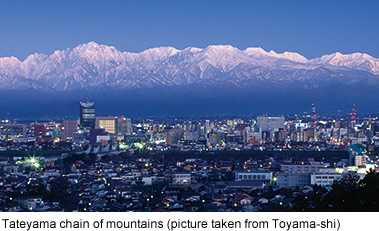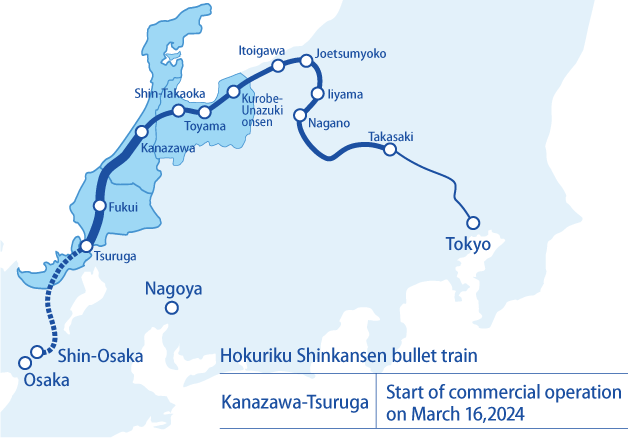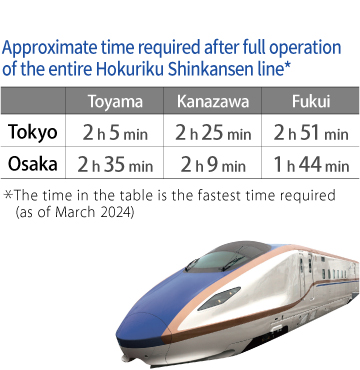 The Hokuriku region, our service area, is conveniently situated within 300 km of Japan's three major metropolitan areas - Tokyo, Osaka and Nagoya. This geographical advantage combines with a desirable natural environment and an abundant labor force to give the region a great growth potential and a promising future.
The Hokuriku region, our service area, is conveniently situated within 300 km of Japan's three major metropolitan areas - Tokyo, Osaka and Nagoya. This geographical advantage combines with a desirable natural environment and an abundant labor force to give the region a great growth potential and a promising future.
The development and expansion of transportation systems have reduced the traveling time between Hokuriku and other regions of Japan, particularly the three major metropolitan areas, leading to further promotion of human and economic exchanges.

 In the field of road transportation, the Hokuriku Region it is directly connected to the Tokyo metropolitan area, the Chukyo area, and the Kansai area. The Tokai-Hokuriku Expressway is being converted to four lanes after the opening of the entire line, and conneces the Hokuriku Region to the Chubu region along routes with the Hokuriku Expressway. The Maizuru-Wakasa Expressway, which connects the Chugoku Expressway, the Meishin Expressway, and the Hokuriku Expressway, has been fully opened, greatly improving access between regions.
In the field of road transportation, the Hokuriku Region it is directly connected to the Tokyo metropolitan area, the Chukyo area, and the Kansai area. The Tokai-Hokuriku Expressway is being converted to four lanes after the opening of the entire line, and conneces the Hokuriku Region to the Chubu region along routes with the Hokuriku Expressway. The Maizuru-Wakasa Expressway, which connects the Chugoku Expressway, the Meishin Expressway, and the Hokuriku Expressway, has been fully opened, greatly improving access between regions.
On the other hand, in the field of air transportation, it is possible to travel from Noto Satoyama Airport, Komatsu Airport, and Toyama Kitokito Airport to major cities in Japan in one hour, and international flights are operated at the airports of Komatsu Airport and Toyama Kitokito Airport. In the field of marine transportation, the functions of important ports such as Fushiki Toyama Port, which is an international hub port in the Hokuriku region, as well as Nanao Port, Kanazawa Port, and Tsuruga Port, are being strengthened.
Hokuriku has a rich cultural heritage and a wealth of scenic and historic sites, and many traditional crafts fostered by the cultural climate of the region are still thriving.
To the east lie the Japan Alps, a range of mountains rising 3,000 meters above the sea. From these mountains flow the rivers that provide Hokuriku with plentiful water resources. The low-cost, abundant hydroelectric power generated by abundant water resources of these rivers led to early development of steel, chemical and textile industries. In addition to its role as a major production center for aluminum products, machinery and other goods, Hokuriku is home to numerous world-famous enterprises and is the leading industrial region along the Sea of Japan.